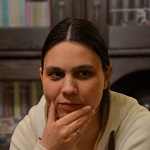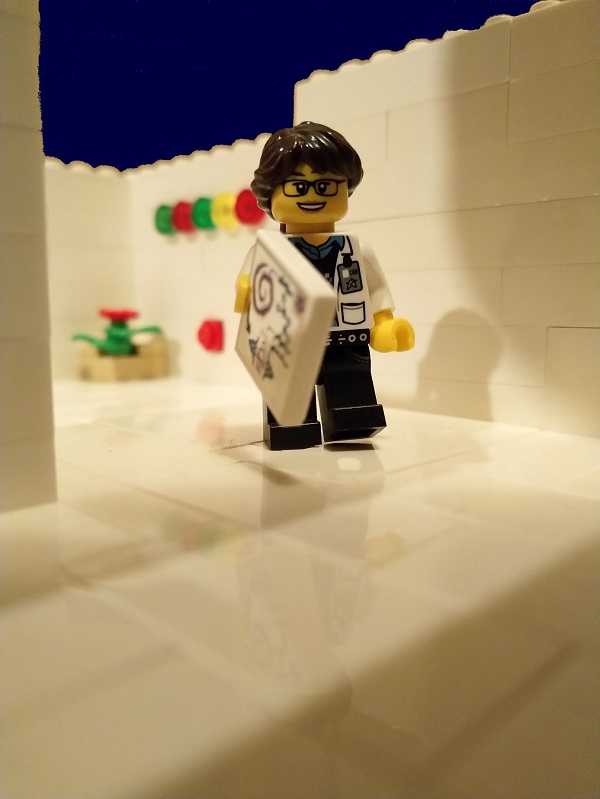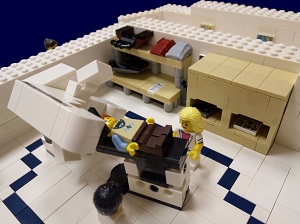LEGO radiotherapy - PDF version
LEGO toys have been part of our kids’ lives for decades. Everything can be constructed that can be imagined. And reality can be modelled too. It was a hard task to collect enough white elements... but now we have finalised our LEGO model of our medical linear accelerator (TrueBeam) with its whole bunker, cone-beam CT, modulator cabinet, electron applicators, patient immobilisation equipment, head & neck masks, measuring instruments and the staff. There is no similar LEGO set and some of the special LEGO parts were difficult to procure - for instance, LEGO does not produce belly boards or fixation masks. It was an exciting challenge for me and my children (6, 8.5 and 10 years old)! We spent a whole summer holiday on the construction, and they did not run out of enthusiasm until our little project was done. We had put the design of a TrueBeam bunker on the floor and together wondered how we were going to build it with the given bricks. A week after having started the building, I had to a couple of times order more bricks for us to continue with the work. When I took the completed model to my department, my children went on to build an other linear accelerator just for home use. In hind sight it is difficult to decide what was more enjoyable: constructing or playing.
In a busy department, besides the routine clinical work, it is impossible to show the process of radiotherapy treatment in detail. There is no or very little time to interrupt the clinical workflow in order to explain the devices and treatment steps to students. We planned and built this linear accelerator bunker to help to demonstrate the practices that are discussed in university lectures, but I can also give presentations and demonstrations that aim to popularise radiotherapy to ordinary people or patients.
A focus on the details was an important issue during construction. The thickness of the radiation protection wall of this model is true to scale and the gantry, the collimator and patient table move isocentrically. Furthermore, the patient table is a '6D table', which means it can be rotated in every axis, reminiscent of pitch and roll in aircraft. This real model of a state-of-the-art medical accelerator bunker can help radiation therapy professionals to demonstrate the treatment process to students, patients and children.
If our project gets enough support, LEGO might consider making it available for others too with mass production! We need 10000 votes in two years. So, if you would like the opportunity to get a linac for home or for demonstration purposes, please, vote for our linac project on:
https://ideas.lego.com/projects/3838a438-3c6f-4321-869e-5619603179ad
Furthermore, my children and I made a short (2.5 min) video about external beam radiotherapy for paediatric patients. The movie playfully demonstrates what will happen with them during radiotherapy, which is likely to reduce their fear and anxiety.
We used a stop-motion technique to shoot the movie. It is in Hungarian but has English subtitles. We believe that it could be useful for psychological preparation of our little patients, so I have shared it on my webpage:
- in Smartphone optimised resolution (40 MB):
http://chopin.web.elte.hu/Gina_LEGO-movie_iPod
or
- in full HD (400 MB):
http://chopin.web.elte.hu/Gina_LEGO-movie_FHD17M
Our wish would be that the LEGO bunker and the movie would be only a popularising tool, and children would never need to meet the real equipment.
Share it, use it, enjoy it!
Gina & kids

Georgina Fröhlich, PhD
Medical physicist
National Institute of Oncology
Centre of Radiotherapy
Budapest, Hungary
E-mail: frohlich.georgina@gmail.com
Web: http://chopin.web.elte.hu/
Figures
.jpg.aspx)
The bunker with a TrueBeam linear accelerator

The Physicist
.jpg.aspx)

The Physician and the tTechnician set up the patient

The linac with the patient on the treatment table